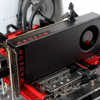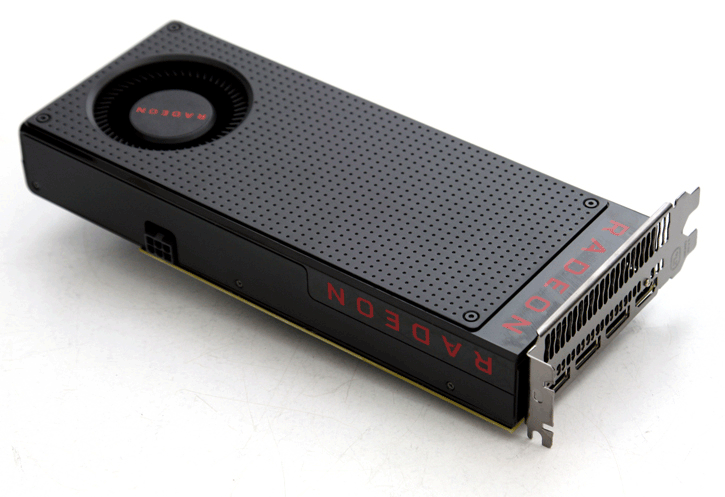Final words and conclusion
Final words and conclusion
By positioning the Radeon RX 480 in a more mainstream segment AMD is making a tremendously brutal effort, as they are offering high-end performance at a very good product price positioning. We have yet to test the 4 GB model, but we think that is going to be the sweet spot model selling at 199 USD. Remember, the memory on that one is clocked a notch lower at 7 GHz effective. That alone is not going to make a big difference. The Radeon RX 480 in its 8GB volume size is something I'd recommend for the ones with multiple monitors and/or those who like to play around with VSR and a resolution domain of 2560x1440. For the extra 30~40 bucks I would recommend you opt for the 8GB model though, as clearly it'll be a little more future proof.
Aesthetics
The Radeon RX 480 reference cards have a bit of a nice dark feel to them with subtle changes in the logo and logo coloring. Honestly, I think the product looks terrific. Once you have it in your hands it is a little plasticky and light though, but at 199 or 239 bucks you'll agree with me, that's a good looking product. Being on the value side of things the card does not come with a backplate. Overall it's just a good looking, reasonably sturdy product.
Performance
Performance wise you just cannot be anything other than thrilled about the Radeon RX 480. Now, the card is a bit all over the place; extremely fast in fill-rate limited games, a little less with GPU stringent ones but overall you are looking at a product that competes with the GeForce GTX 970 and sometimes even 980. What was baffling to see though is that this 8GB model is often spot on in performance with the Radeon R9 390 series and thus R9 290 series as well. And that actually might be a problem. See, many of you are already in the 390 or Fury series and seen from that product perspective, the RX 480 will offer nothing new other than a few features. However, as we rewind that to where you are on a 280/280X/280 series graphics card, well, for 199 or 229 USD you are in for a treat in terms of performance and value. Let's not forget about other features; the Radeon RX 480 and Polaris 10 overall will offer proper performance, Eyefinity features and PCIe gen 3 compatibility and all the other stuff like HDMI 2.0b, DisplayPort 1.4 with HDR support and so on. The Radeon RX 480 series is a proper DirectX 12 product right from the get-go and has that little extra bite thanks to an increased number of shader processors (2304).
Who Would The Radeon RX 480 8GB Be Best Suited For?
As always, the answer to that question is a little complex. I would say that you'll need to look at your monitor and game preferences first and foremost. This card at its given price range makes quite a lot of sense right now for 1080P and 1440P. It is a very capable 2560x1440 resolution gaming graphics card and it obviously makes for a truly excellent 1080P card as well. Especially at that monitor resolution the card makes so much sense. But granted, at WQHD (2560x1440) most games run well enough. Another benefit is that at least the most elementary and arbitrary DirectX 12 Feature levels are supported in hardware. Even on very harsh-on-the-GPU titles you'll refrain from un-ticking graphics quality options to gain on framerate performance, there's very little trade-off to be made as the RX 480 will deliver enough. In short, for the money this is an excellent 1080P and a proper 1440P card that will often offer a nice 40~60 FPS experience at WQHD and proper image quality settings. It has plenty of muscle and has the graphics memory to deal with it, even with the best quality settings and some niche AA levels. Resolutions after 2560x1440 will be more complicated. Price to performance wise one should also take Crossfire into consideration. However, with multi-GPUs also comes 0-day driver issues with game releases. We'll test it at some point but two Radeon RX 480 cards set up in Crossfire might be a very sweet solution for Ultra HD gamers or the ones who like to go a little nasty with VSR and, of course, the latest gaming titles. Performance wise, most games will run seriously well at the very best image quality settings at 2560x1440. And sure, the cool factor remains that you get the advantages of an 8 GB framebuffer (if you opt for that model). With 8GB we feel the card is rather future proof as well.
Pricing
Value wise the Radeon RX 480 is simply making a lot more sense compared to anything the market currently offers. I think anyone will agree with me on that. Nvidia has been driving the prices upwards, and, being a bit of an underdog, AMD traditionally always tries to offer that little extra value wise. Typically the high-end class product hovers at the 500 USD marker. Nvidia, when they released it, drove the GTX 970 to 399 USD and the GTX 980 to 549 USD. The Radeon RX 480 is often close to that GTX 980 or in-between the GTX 970 and 980. So at 229 USD / 259 EURO for that 8GB version that just means pure value. If you are comfortable with 4 GB (which is totally fine even at 2560x1440), then the price is a terrific 199 USD / 219 EURO.
Cooling and Noise levels
Not everything is perfect on the reference model. the Radeon RX 480 will not be a silent card. The temperature limiter for the reference products is set at 80 Degrees C, much like the competition. The card is relatively silent, however once it passes roughly 75 Degrees C, the noise levels will increase. Once it passes 80 degrees C it'll even become a bit audible. We foresee this to be something that will be eliminated with the custom cooled board partner cards though. But the reference cards are not at a level that i would tag as silent. The cooler itself works really well, the card does exhaust a lot of hot air, however the thermal design exhausts that air properly outside the PC.
Power Consumption
The board is rated by us at roughly 150 Watts TDP, that means when you completely stress it, that's the power consumption. Our measurements showed that the board TDP is indeed roughly in that Wattage region, we measured a little higher but with some games also noticed lower wattages. The move to 14nm FiNFET obviously is testimony to a great perf/watt ratio. We feel that at 150~160 Watts the card is consuming very reasonable amounts of power for this kind of performance. No complaints here really.
Overclocking
Nvidia recently made a move towards a more complicated way of overclocking, more restrictions, more sliders more complication. Unfortunately AMD is mimicking that. The new overclocking features are pretty much a 1:1 copy of what team green did. I wish they wouldn't have gone there as, honestly, I do not like the Nvidia implementation one bit either. Give me a voltage slider, a MHz increase (offset) and fan control. That's what I want and need, not the endless unneeded nonsense that both teams now have implemented. Overclocking wise we could get the card stable at 1325~1375 MHz oming from a 1267 MHz boost clock. The 1375 MHz was really pushing it though. I expect most cards to settle at ~1325 MHz. The memory will reach anywhere from 8.8~9.0 Gbps (for the 8 GB model). Overall these are satisfying results albeit we needed extra cooling and that created more noise.
Final Words
I like the Radeon RX 480, I really do. But considering it is so very close to the 390 series I do foresee a problem. Anyone that is already in that performance bracket will simply skip this product and wait for Vega (AMD's future replacement for the 390 series). But it works both ways, anyone looking for an affordable upgrade to a WQHD capable graphics card coming from say a 280/380... well, this card series will offer killah value for money. For the reference card I do have some reservations about the cooler in terms of noise levels. It could be isolated to our sample, but other reviews and user experiences will be the decisive factor on that. My one gripe with the reference cards is that they do not come with a DVI connector. Especially in this price segment there will be a lot of 2560x1440 users looking puzzled. Lots of such monitors do not have DP and since HDMI at that standard does not support 2560x1440, they will need a dual-link DVI connector. It's an ongoing trend at AMD, and imho a rather regrettable choice. We do hope that some AIB partners will implement DVI, some PCB SMT traces do show that it is possible. Other than that, the Radeon RX 480 8GB is obviously a little gem for the serious gamer with a proper monitor as it just oozes value. A nice plus is the lower power consumption. We consider the Radeon RX 480 4GB and 8GB to be a first run in the new high-end performance cards. I am very interested to see what the Radeon RX 470 will bring to the table and, obviously and inevitably, the Radeon RX 490 series. If you are in need of an upgrade right now, for roughly 200 bucks you get a product that competes with Radeon R9 390 and Geforce GTX 970/980 performance levels while being DX12 compatible and offering all the new, hip display connector features as well. The Polaris 10 architecture seems very sound and proves it can deliver big-time whilst remaining in line power consumption wise, we do think it is merely a small iteration over GCN Generation 3, the die-shrink with 14nm FinFET is the biggest benefit in terms of relative performance and wattage. Heat and noise wise I'd like to declare the product as 'OK', but would advise a custom cooled AIB product if you need sheer silence.
It will be interesting to see how Nvidia is going to adapt to this rather brutal release, at this time we see prices for the GeForce GTX 970 dropping towards 284 EURO and yesterday all of the sudden that GeForce GTX 1060 photo appeared. Interesting times! Anyway let me wrap it up. Overall the Radeon RX 480 series will have that extra bite that the current high-end cards feel some comfort in. With a price difference of almost 30 bucks for the 4GB model, value for money wise this card is the way to go. The Radeon RX 480 is, overall, a little beast for Full HD and WQHD gaming combined with the better image quality settings, as well as for its features and aesthetics. As such, the Radeon RX 480 8GB (and 4GB) are true value products.
** updated final euro prices, the 4 GB model is listing at 219 incl VAT and 259 EURO for the 8GB models. Prices will vary a bit per EU country. UK prices are 180 and 215 pounds respectively.
Recommended Downloads
- Sign up to receive a notice when we publish a new article
- Or go back to Guru3D's front page



